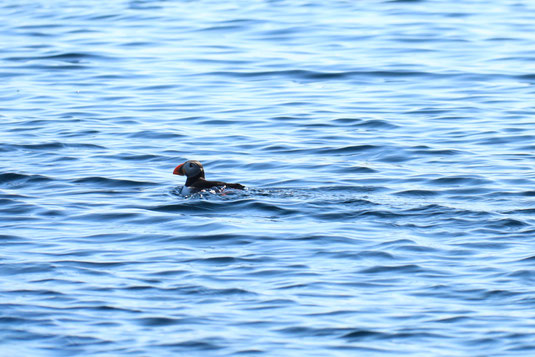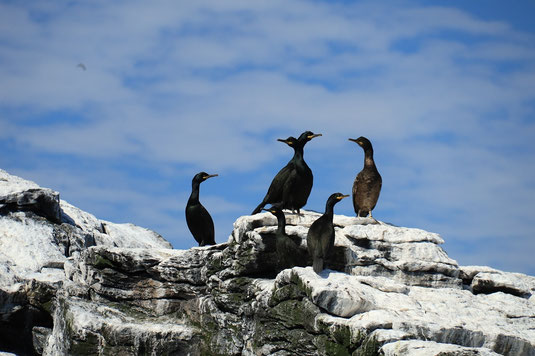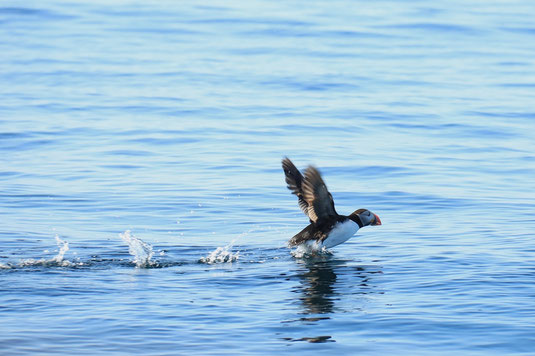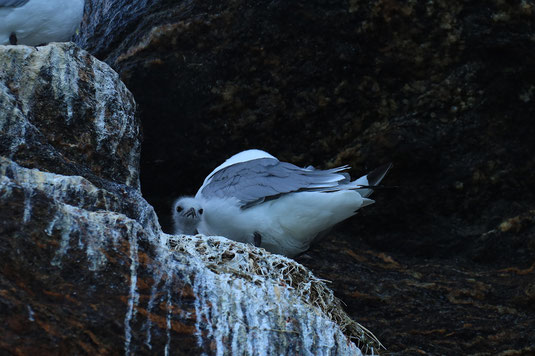In Search of Puffins—Roadtrip Norway Lofoten Islands II.
August 19, 2023

"PUFFINS!" I shout excitedly and shake my boyfriend with both hands as if I had just won an award. Probably the
award for the passenger displaying the biggest bird. But that's what it's all about: the bird. This is the bird I've wanted to see in the wild for many years: a puffin. A PUFFIN!
Those puffy black and white birds with big orange beaks that look like fluffy, flying penguins!
We're on the ferry to Røst, about three hours by sea from the main islands of Norway's Lofoten Islands. Røst is a tiny island municipality far out in the North Atlantic, that has no physical connection to the outside world other than one ferry and a mini-airport for small planes.
Puffins live near there.
If I were a Puffin, I would live there, too. Far away from all the fuss and noise of people.
For the three hundredth time, I nervously check to make sure I have all my spare camera batteries. What if seagulls come and steal them from me?
Around 1 PM we arrive. Røst. A few red, wooden Norwegian houses and a small harbor. A small center console boat and its skipper are waiting for us. We now start off on a four-hour exploration of tiny rocks, cliffs, and bays. Always keeping a lookout. Waiting. Hoping.
Puffins—cute and endangered

The sun is high in the sky, it is surprisingly hot. I squint at the water. Wasn't there something out there? Our guide looks somewhere else and begins to tell us a sailor's yarn. Obviously, he's not as terribly excited as I am. But he sees puffins every day.
With some jobs, you don't know if they will be super cool forever or eventually get super boring when you do them over and over.
But how can animal-watching ever get boring!
We see several black toothpicks on a rock. As we approach, they suddenly look like cormorants. They are not disturbed at all by our boat; they seem more interested in enjoying the warmth and the wind on their stone beach lounger. Right next to them a gray heron is preying on fish. It's all about fish. No bird flies or swims around here just for fun.

Fish or no fish—thanks to overfishing of the puffin’s food by humans—has caused a massive decline in the puffin poppulation around Røst. Many chicks starve to death. In the late 1970s, the world’s largest puffin colony existed around Røst with nearly 1.5 million breeding pairs. In 2015, there were only 289,000 pairs.
Global warming is also playing a role. The water temperature is slowly warming up, causing ocean currents to change and fewer food fish now swim near the puffin’s nesting grounds. So, puffins have to fly further and search longer for their food, and they become exhausted.
While traveling, it is these insights and stories into nature and history that interest me at least as much as simply taking interesting and beautiful photos. They may make you sad, but they also motivate you to do something to change the situation. You may not be able to save the entire world, but you can start by helping a small bird by supporting animal welfare projects or studies.
Puffins on Røst: 200 feet deep, 30 years long

Finally, we spy numerous dark specks in a bay that are bouncing on the water and bobbing on the waves. Puffins! I'm freaking out. When you have a desire to see something for a long time and then suddenly it is there right in front of you—it is like Christmas! Black and white, puffy and with big, red beaks, they bobble around in the blue-green water. So cute and beautiful! But you can't, nor should you try, to approach them because such action stresses the birds. They are shy and fly up quickly.
They flap their wings like a butterfly—up to 400 times per minute. The wings not only help them fly, but are especially practical under water, when they become diving fins. They enable the puffins to dive down to almost 200 feet deep. A puffin winter is spent completely on the water, where they eat and sleep. They may live up to 30 years.
Puffins are very intelligent. They even use tools! Researchers have discovered that the birds use sticks to
scratch themselves.
I look at the sea below us. In January, the temperature is probably not warmer than 40 degrees Fahrenheit. To sail around on the sea for the whole winter with a wet butt does not sound tempting to me. On the other hand, I don't have a fluffy feathery butt.
The bullet hole in the lighthouse of Skomvær

In addition to puffins, we see guillemots and razorbills, which look even more like little penguins. On a cliff above us, seagulls are breeding. I have no real fondness for seagulls, after the evil birds have stolen food (ice cream, chips, waffles, rolls, etc.) from me several times. Even the little baby gull peeking out of the rock hole above looks aggressively hungry.
"I already ate my sandwich," I say out loud.
We make a quick stop at Skomvær, a tiny island at the far end of the archipelago. A lighthouse stands watch there and two people live here every summer with sheep and vegetable garden. We get a short tour of the still active lighthouse. Particularly impressive is the huge bullet hole in the lens which focuses the light radiating into the distance darkness. During World War II, the Nazis fired at the lighthouse trying to hit a kerosene tank, which would cause the tower to explode (what's wrong with us humans?). Fortunately, the bullets didn't hit the kerosene. However, we were told that the crystal glass is still broken because the knowledge of how to create this particular type of glass has been lost.
Our tour with Day@Sea was so much more than a simple fulfillment of my longtime desire to see puffins. There are so many wondrous and terrifying things in our world—and every trip out into that world makes you a little bit wiser.
Find more of our wild northern adventures here:
- In Search of the Midnight Sun - Roadtrip Norway Lofoten Islands I
- On the Edge of Fjords and Glaciers – Roadtrip southern Norway
- Roadtrip Iceland
- Highway to Hell: Adventure Trip on the Dalton Highway in Alaska
- Glass Gardens, Snow Avalanches and the Mount St. Helens Eruption - Roadtrip USA Northwest I





